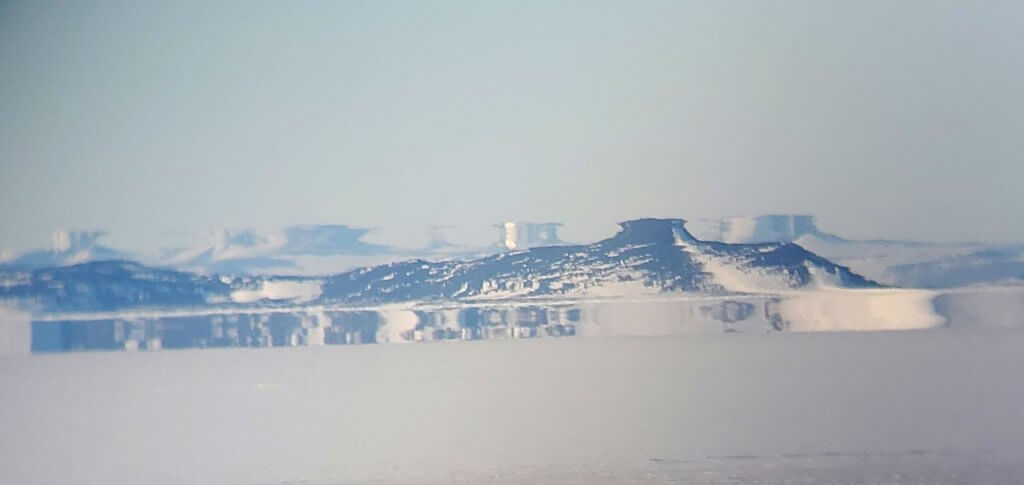Fata Morgana: Mirage in the Mountains
by Chris Paige
Broadcast 1.1996, 3.2019, and 12.29.2021 & 1.1.2022

Black Island in Antarctica distorted by a Fata Morgana. Photo by John Meyer, public domain.
Listen:
My husband and I were skiing recently on a gloriously sunny day in a secret powder paradise. Several inches of fluff billowed up with each kick and turn as we tracked through the trees. Breaking into a clearing, we gazed out across white-frosted mountains. On the far horizon, we could see clear to…the buttes of Utah?
Wait a minute! There, far to the south, as clear as day, were square-topped mesas and rugged-looking buttes looming on the horizon where we knew there should be snow-capped peaks. For all the world it seemed like we were gazing at the canyon country of southern Utah. We were seeing a mirage—a type of mirage called a Fata Morgana.
Mirages occur when layers of cold and warm air distort the light coming to your eye. For example, in the classic desert mirage, a layer of warm air hovers just over the surface of the earth and is topped by a layer of denser, cooler air. Light traveling from the cool air down through the warm air is bent, and an image may appear upside-down. A palm tree in the distance may seem to be reflected in shimmering water. The palm tree is real, but its reflection is the image bent upside-down by the warm air, and the “water” is actually an inverted image of the sky.

Fata Morganas are a type of superior mirage, caused when warm air is stacked on layers of cool air. Graphic created by Ludovica Lorenzelli, DensityDesign Research Lab, CC 4.0.
A Fata Morgana is a complex mirage. It occurs when many layers of warm and cold air are stacked one on top of the other. These layers act like eyeglass lenses, and each layer bends the light slightly differently, producing an image that looks like cliffs, a cityscape, or castle towers looming over the horizon. To our eyes that day, the mountains were distorted into an image of towering buttes and mesas.
Fata Morganas often occur in the Arctic. Sunlight reflecting off sea ice through layers of warm and cold air produces mirages that look like great cliffs and palisades. In his book Arctic Dreams, Barry Lopez notes that Crocker Land, the Barnard Mountains, President’s Land, King Oscar Land, Petermann Land—places described and mapped by seasoned explorers—were never found again. Lopez also notes that sometimes later expeditions would see the same Fata Morgana, however, and the confusion would persist.
The name Fata Morgana is Italian and means “Morgan the Fairy.” In legend, Morgan was the sorceress sister of King Arthur and was known for her ability to conjure up towering castles in the air. Settling Normans brought the King Arthur story to Italy. By the nineteenth century, a mirage of towering castles often seen in the Strait of Messina off the coast of Sicily became known for the Fairy Morgan.
Morgan the Fairy was at work in the mountains that day as we gazed on ephemeral buttes and mesas, adding to our delight on a sunny afternoon. But we didn’t have to rewrite the map, for as we watched, the mirage slowly dissolved, and mountain peaks reformed in their proper places.
Every week since 1991, Field Notes has inquired about Montana’s natural history. Field Notes are written by naturalists, students, and listeners about the puzzle-tree bark, eagle talons, woolly aphids, and giant puffballs of Western, Central and Southwestern Montana and aired weekly on Montana Public Radio.
Click here to read and listen to more Field Notes. Field Notes is available as a podcast! Subscribe on iTunes, Google Play, or wherever you listen to podcasts.
Interested in writing a Field Note? Contact Allison De Jong, Field Notes editor, at adejong [at] montananaturalist [dot] org or 406.327.0405.
Want to learn more about our programs as well as fun natural history facts and seasonal phenology? Sign up for our e-newsletter! You can also become a member and get discounts on our programs as well as free reciprocal admission to 300+ science centers in North America!












